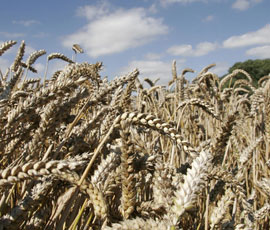JB Diego is top selling winter wheat

The top selling winter wheat variety in the UK this year is the hard Group 4, JB Diego, with almost 12% market share. Louise Impey finds out what it has to offer
Better grain prices may have helped, but it’s the variety’s consistency that is mentioned most often when you ask about JB Diego.
Sales of the high-yielding (104%) feed variety, which joined the HGCA Recommended List in 2008, have risen steadily each year. According to NIAB Seedstats, JB Diego is now the top-selling winter wheat, ahead of Oakley and KWS Santiago, with most commentators predicting that there is further sales growth to come.
Bred in Germany by Josef Breun, but marketed in the UK by Senova, JB Diego started out as a potential milling variety. Having been through the Recommended List system, where it was re-classified as a feed variety, it joined the list in the same year as one other hard feed wheat, Duxford.
Since then, JB Diego has proved to be a reliable and consistent performer, across a range of sites and soil types. And its German origins bring some very welcome genetic diversity to the UK, points out Senova’s commercial director Jeremy Taylor, despite some initial scepticism that this was required.
“When we launched JB Diego five years ago, there was very little interest in the fact that it introduced new sources of genetics,” he says.
“But the subsequent changes in yellow and brown rust races, together with the breakdown of some popular varieties, have changed this mindset. Now, JB Diego’s heritage is seen as an advantage.”
At the farm level, JB Diego is as reliable as they come, comments Richard Torr of Wynnstay Farmers in Shropshire. “It doesn’t appear to have any weaknesses. It can be grown as a first or second wheat, on light or heavy land, from mid-September onwards.”
He notes that the variety’s sales growth has been on its own merits, rather than as a result of a high-profile marketing campaign. “Farmers ask for it. Most have had a positive experience with the variety, and want to repeat it. It’s the wheat they start their planning with, fitting in other choices around it.”
He highlights two particular attributes that make the variety popular in the west. “The grain quality is good, with a high specific weight, and it is reasonably long strawed. Both things suit this part of the world.”
Mr Torr acknowledges that other feed varieties which outyield JB Diego have come along and will compete for its crown. “But they all seem to have issues in the farmer’s eyes and none have comparable grain quality or straw characteristics.”
The strange growing season in 2011 ended particularly well for the variety, he continues. “We had some staggering results last year. JB Diego didn’t appear to go through the dry spell any better than others, but it came up with the goods.”
However, it isn’t suited to the very early drilling slot, he cautions. “That would seem to be its only disadvantage.”
Yellow rust, which has been the downfall of some variety choices, is creeping across to the west, he reports. “We’re aware of the disease and concerned about it. Interestingly, JB Diego’s yellow rust rating has gone up to an 8.”
Case study: Waldersey Farms, Norfolk
Having grown JB Diego for the last five years, farm manager Adrian Kew is very familiar with the variety.
Harvest 2011 results were the best that the 4,455ha (11,000-acre) farming business has ever achieved, despite growing the variety on a piece of land that always suffers from drought.
“We grew 405ha of JB Diego on a sandy soil,” he recalls. “It exceeded our expectations on yield, remained clean and produced a very good grain sample.”
And looking back over the last five years, JB Diego has never failed to perform well, regardless of soil type or rotational position, he adds. “We were one of the first farms to grow it. We try and pick out new varieties coming through the system that will suit our land.”
The average wheat yield at Waldersey Farms was 9t/ha in 2011, reports Mr Kew. “That came from a range of soil types, from heavy to blow-away sands. So we got 12.5t/ha from some of it, and just 6.2t/ha from other parts.”
Feed wheats are preferred, although Soissons was grown until recently. “There isn’t enough margin to continue with milling types.”
However, in both 2010 and 2011, JB Diego earned a £10/t premium. “It went for milling. It has very good grain quality, so is always in demand.”
Standing ability is an important characteristic of any winter wheat variety grown at Waldersey Farms, ends Mr Kew. “We had some KWS Santiago which went down on the fenland last year.”

